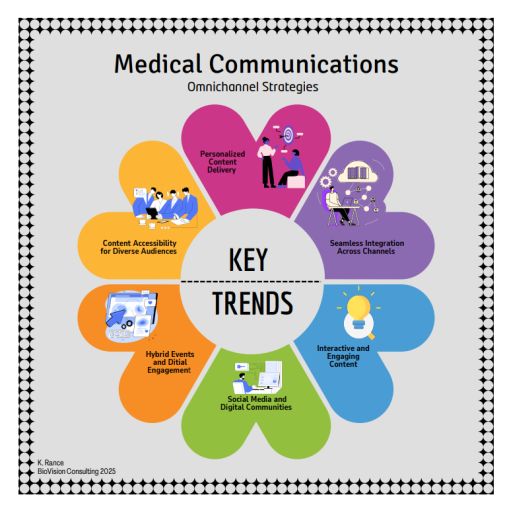
The Future of AI in Medical Affairs: Transforming Healthcare
In 2025, medical communications are increasingly adopting omnichannel strategies due to technological advancements and the growing demand for personalized, patient-centered care. Omnichannel communications integrate various methods—both digital and traditional—to provide seamless, consistent, and personalized interactions across multiple touchpoints.
This approach will continue to evolve, incorporating advanced digital technologies, artificial intelligence, and interactive content to enhance patient-centered experiences. As the healthcare landscape becomes more digital and interconnected, medical communications teams must quickly adapt to ensure that their strategies remain efficient and compliant with regulatory standards.
Here are the key trends and innovations in omnichannel medical communications:
Personalized Content Delivery
- AI and Data-Driven Insights: Medical communication teams are using AI and data analytics to personalize content and communications for healthcare professionals (HCPs), patients, and other stakeholders. Personalized messages, educational content, and treatment updates are tailored based on each recipient's preferences, behaviors, and needs.
- Dynamic Content Creation: AI tools can assist in generating content that adapts to the audience's stage in the treatment journey, offering educational material or medical updates relevant to specific conditions or therapies. This is particularly valuable for engaging Key Opinion Leaders (KOLs), HCPs, and patients with relevant information.
Seamless Integration Across Channels
- Unified Communication Platforms: Medical communications platforms are becoming more integrated, allowing organizations to manage content and messaging across multiple channels—social media, email, mobile apps, websites, webinars, and even virtual care platforms—on one unified system. This ensures a consistent experience for the audience, regardless of how they engage.
- Cross-Channel Interaction: This seamless integration allows stakeholders to move between digital and traditional communication channels, such as going from receiving an email to participating in a webinar or accessing a patient portal for follow-up care.
Enhanced Use of Digital Tools and Platforms
- Telemedicine and Virtual Care: With the rise of telehealth, omnichannel medical communications now increasingly include video consultations, remote monitoring, and virtual clinical trials. These tools are complemented by educational materials and real-time support via mobile apps, improving patient and HCP interactions.
- Mobile-First Approach: As more patients and healthcare providers engage with content on mobile devices, medical communications are increasingly optimized for smartphones and tablets. This includes patient portals, mobile-friendly educational resources, and notifications for appointments, updates, or new research findings.
Real-Time Communication & AI-Enhanced Interactions
- Chatbots and AI-Driven Communication: AI-powered chatbots are being used in medical communications to provide real-time information to patients and HCPs. These tools can answer common questions, assist with appointment scheduling, provide medication reminders, and even offer basic health advice based on a patient's profile.
- Virtual Assistants for HCPs: AI-driven virtual assistants are being integrated into HCP workflows, providing them with tailored clinical information, product updates, or research summaries instantly, helping to streamline medical affairs interactions.
Interactive and Engaging Content
- Multimedia Integration: Medical communications are increasingly incorporating interactive content such as videos, webinars, podcasts, and infographics to engage audiences. These multimedia formats help to explain complex medical concepts, research findings, and therapeutic options more effectively.
- Interactive Education for Patients and HCPs: Online learning platforms, virtual reality (VR), and augmented reality (AR) are enhancing the educational experience for both patients and healthcare providers. For example, VR simulations can help medical professionals better understand disease pathophysiology, and AR can show patients the effects of certain medications in a more visual and engaging way.
Social Media and Digital Communities
- Social Media Engagement: Social media is becoming an increasingly important channel for medical communications. In 2025, pharma companies, medical organizations, and healthcare professionals are leveraging platforms like LinkedIn, Twitter, and even more specialized platforms like Doximity to share medical insights, research findings, and educational content.
- Patient Advocacy Groups and Online Communities: Social media and online communities (such as Reddit or patient-specific forums) are becoming crucial for patients to share experiences, ask questions, and receive support. Medical communications strategies now involve collaborating with these online communities to provide valuable, accurate information and support.
Data Privacy and Ethical Considerations
- Compliant Communication Channels: With increasing concerns around data privacy (e.g., HIPAA, GDPR), medical communications in 2025 must be conducted through secure, compliant channels. Omnichannel strategies ensure that all communication platforms meet regulatory standards and offer patients and HCPs a secure way to interact.
- Ethical AI Use: As AI continues to play a central role in content delivery, it is essential to ensure that AI tools in medical communications are used ethically—ensuring data privacy, transparency, and avoiding biases in communication and content creation.
Content Accessibility for Diverse Audiences
- Multi-Language and Cultural Sensitivity: With an increasingly global patient population, omnichannel medical communications will offer content in multiple languages and formats, considering cultural sensitivities and regional regulations. This is particularly important for multinational pharmaceutical companies aiming to engage a diverse audience.
- Accessibility Features: Ensuring that content is accessible to people with disabilities (e.g., providing subtitles for videos, screen reader compatibility) will be a significant focus in 2025, making it easier for patients with visual or auditory impairments to engage with important medical information.
Hybrid Events and Digital Engagement
- Hybrid Medical Conferences: Hybrid events, combining in-person and digital experiences, are becoming the norm for medical conferences and educational sessions. These events offer flexibility for attendees to choose how they engage with presentations, Q&A sessions, and networking opportunities.
- Virtual Advisory Boards and Focus Groups: Pharma companies will increasingly rely on virtual advisory boards and focus groups, powered by digital platforms, to engage with KOLs and get feedback on products, clinical trials, and market strategies.
Conclusion
Omnichannel medical communications are transforming how healthcare information is delivered and received. As technology advances, the integration of AI, real-time data, and engaging digital platforms ensures that medical affairs teams can deliver more effective, ethical, and accessible communication across a wide range of audiences.
Leave a Comment
Empowering Innovation in Medical Affairs
Connect with BioVision experts and discover personalized solutions that fit your needs.
Get In Touch With BioVision

